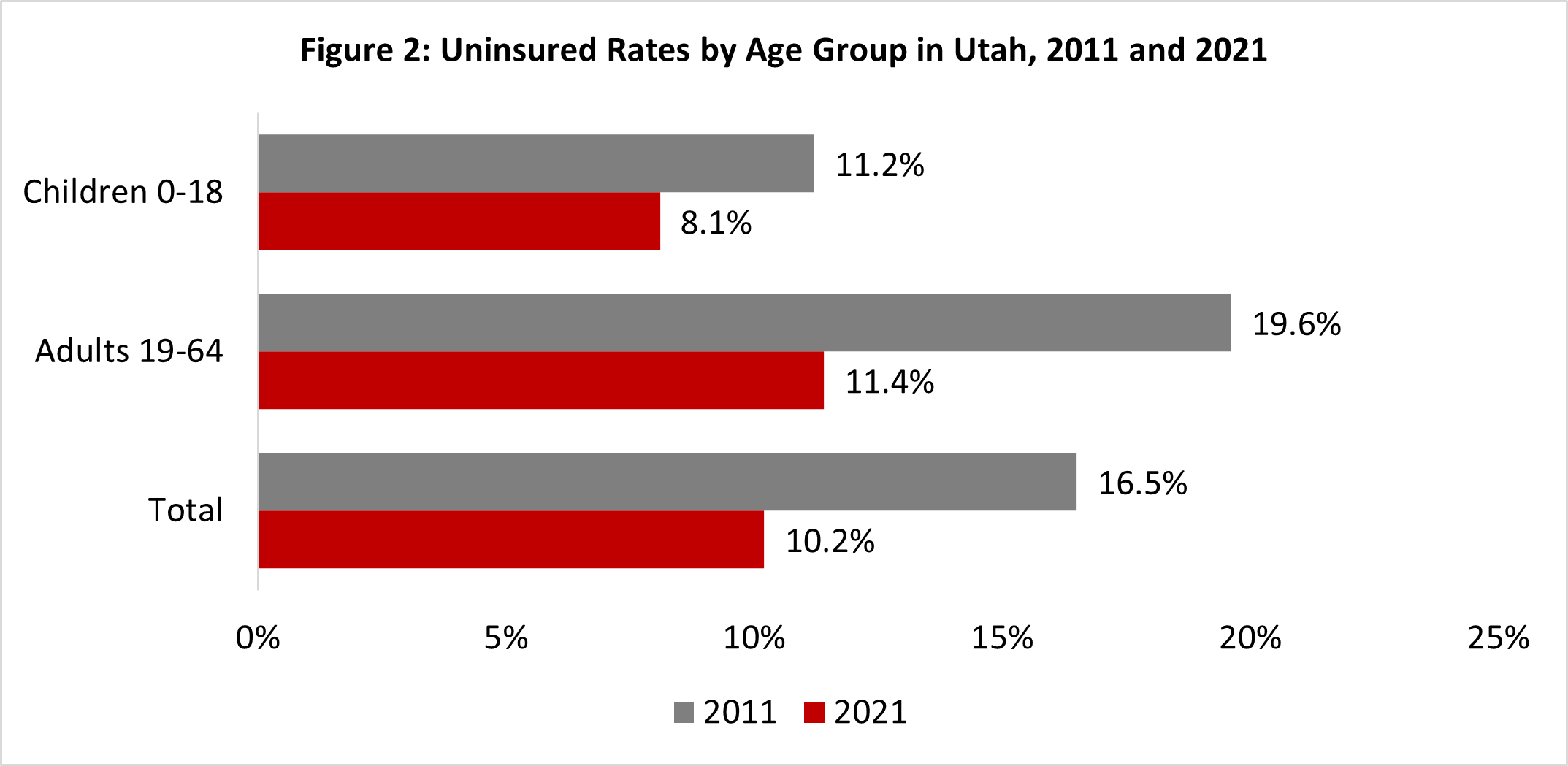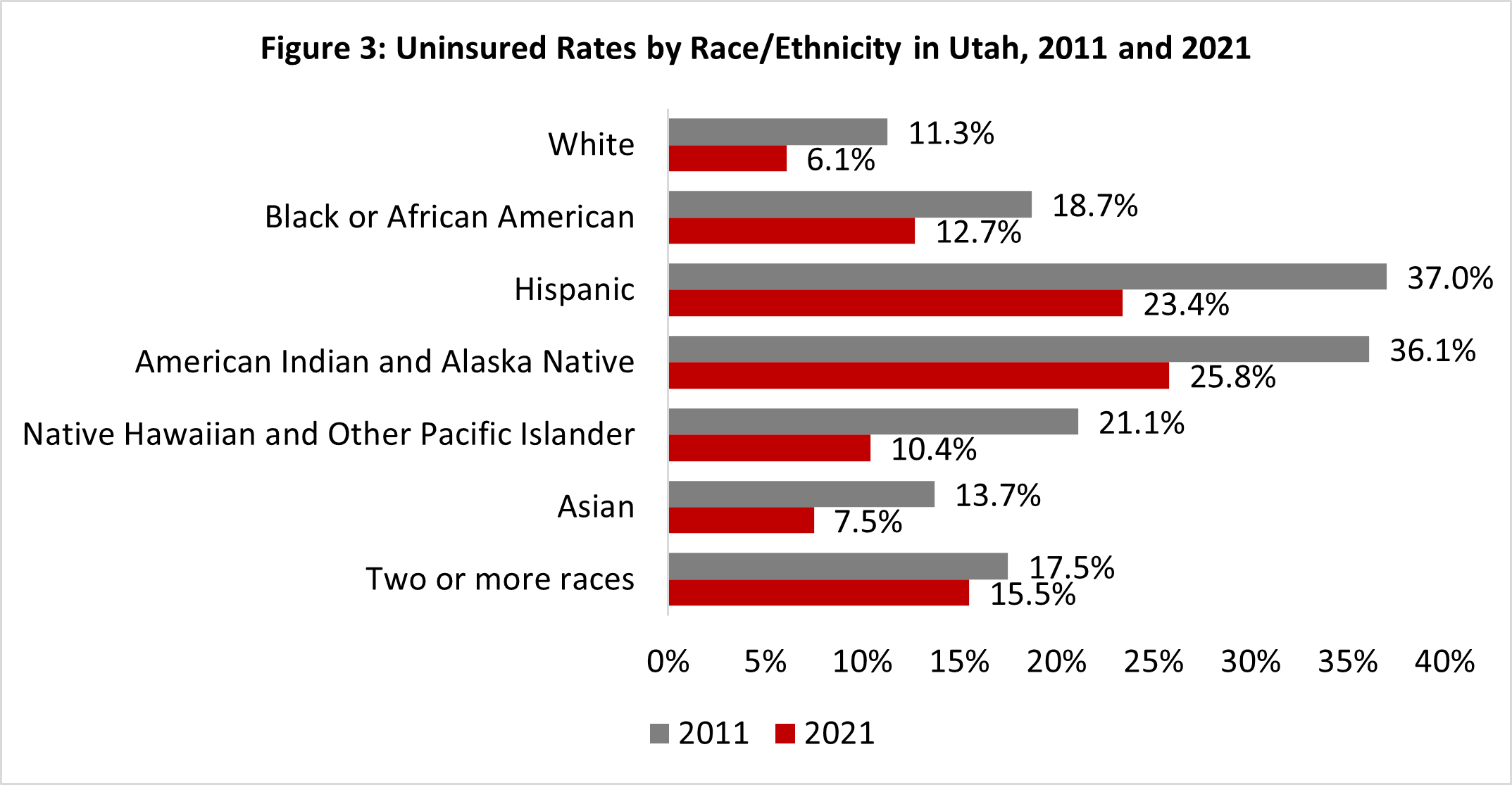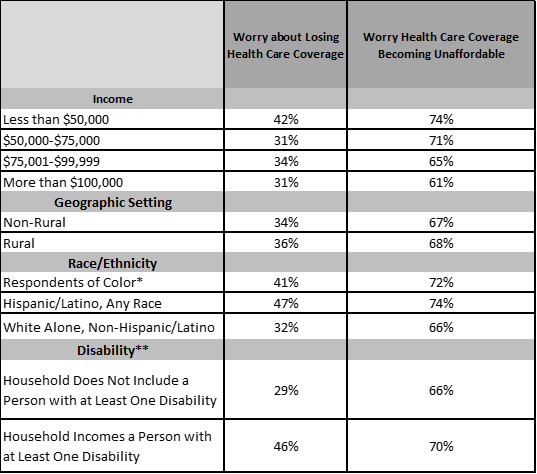Blog Post
Insight: Concerns About Affordability Continue to Frame Utah’s Changing Health Care Coverage Landscape
By: Melanie Beagley
Sep 27, 2023 – The last decade saw significant changes to the health care coverage landscape in Utah and across the U.S. The passing of the Affordable Care Act (ACA) ushered in efforts to expand health care coverage to population groups historically uninsured or underinsured, including households living near or below the federal poverty level and young adults. It also supported certain employers in providing health care coverage to their employees[i],[ii] and prohibited health plans from denying coverage based on preexisting conditions.[iii]
In January 2020, Utah implemented Medicaid expansion, extending Medicaid eligibility to new population groups including low-income adults with income just above the federal poverty level. A few months later, the federal public health emergency (PHE) was declared in response to the COVID-19 pandemic. The federal PHE required states to provide continuous Medicaid coverage to enrollees in the Medicaid program. In December 2022, Congress set March 31, 2023 as the end date for continuous Medicaid coverage triggering the start of a nearly year-long process of unwinding continuous coverage of Medicaid in Utah. This process removes enrollees from the program who are no longer eligible for Medicaid benefits or have not completed the necessary paperwork for maintaining coverage.[iv]
Each of these policies impacted health insurance access and affordability for Utahns. Despite significant increases in health care coverage in Utah over the last decade (between 2011 and 2021, the uninsured rate in Utah dropped by 6 percentage points),[v] a large number of people in the state remain uninsured and many Utahns express a growing concern over the affordability of health care coverage now and in the future.[vi]
The State of Health Care Coverage in Utah
Employer-based coverage, Medicaid, and Medicare provide health care coverage for the largest share of Utahns. In 2021, 59.3% of Utahns accessed health care coverage through their employers, followed by Medicaid (11%), and Medicare (10.2%).
Between 2011 and 2021, large gains in health care coverage were experienced among Utahns under 100% of the federal poverty level (Figure 1) and the adult population (Figure 2).[vii],[viii]
Source: Kaiser Family Foundation (KFF) estimates based on the 2011-2021 American Community Survey, 1-Year Estimates. ACS includes a 1% sample of the US population and allows for precise state-level estimates. The U.S. Census Bureau’s poverty threshold for a family with two adults and one child was $21,811 in 2021.
Source: Kaiser Family Foundation (KFF) estimates based on the 2011-2021 American Community Survey, 1-Year Estimates. ACS includes a 1% sample of the US population and allows for precise state-level estimates.
Gains in health care coverage were also experienced across race and ethnic groups in Utah. The most significant increases were among Utah’s minority population groups (Figure 3).[ix]
Source: 2011-2021 American Community Survey, 1-year estimates. Table S2701. ACS includes a 1% sample of the US population and allows for precise state-level estimates.
Growing Concern Over Health Care Affordability in Utah
Despite these gains in health care coverage over the last decade, many Utahns express concerns with the affordability of coverage and health care. A recently published survey by the Healthcare Value Hub finds one in two Utahns surveyed experienced some type of health care cost burden in the previous year, including remaining uninsured due to cost.[x]
In addition, most Utahns express concern over affording health care coverage in the future. These concerns are represented by Utahns across incomes, races, ethnicities, geographic setting, and disability status (Table 1).[xi]
Table 1: Percent of Utahns Worried about Health Care Coverage Affordability, by Income Group, Geographic Setting, Race, Ethnicity, and Disability Status, 2023
Source: 2023 Poll of Utah Adults, Ages 18+, Altarum Healthcare Value Hub’s Consumer Healthcare Experience State Survey
* The Respondents of Color variable includes respondents who identify as American Indian or Native Alaskan, Asian, Black/African American, Native Hawaiian or Other Pacific Islander, and Hispanic or Latino. Sample sizes not large enough to report data for the independent categories of races.
** Respondents were asked if they or someone in their household identifies as having a disability or long-term health condition related to mobility, cognition, independent living, hearing, vision and self-care.
As the dust settles from the COVID-19 pandemic and the federal mandates that sustained health care coverage for thousands of Utahns, a clearer picture of Utah’s health care coverage landscape will likely come into view. The state will have a better understanding of the impact of Medicaid expansion, the unwinding, and whether the large gains made in health care coverage over the last decade are continuing—or whether concerns about affordability that exist across populations are being realized.
Note: The opinions expressed are those of the author alone and do not reflect an institutional position of the Gardner Institute. We hope the opinions shared contribute to the marketplace of ideas and help people as they formulate their own INFORMED DECISIONS™
Melanie Beagley is a public policy analyst at the Kem C. Gardner Policy Institute.
Endnotes
[i] Rand Corporation. The Affordable Care Act in Depth. Accessed September 8, 2023. https://www.rand.org/health-care/key-topics/health-policy/aca/in-depth.html
[ii] The Internal Revenue Service. Affordable Care Act Tax Provisions for Employers. Accessed September 8, 2023. https://www.irs.gov/affordable-care-act/employers
[iii] U.S. Department of Health and Human Services. About the Affordable Care Act (ACA). Pre-Existing Conditions. Accessed September 8, 2023. https://www.hhs.gov/healthcare/about-the-aca/pre-existing-conditions/index.html
[iv] Utah Department of Health and Human Services. Unwinding Continuous Medicaid Eligibility. Accessed September 8, 2023. https://medicaid.utah.gov/unwinding/
[v] KFF estimates based on the 2011-2021 American Community Survey, 1-Year Estimates. ACS includes a 1% sample of the US population and allows for precise state-level estimates.
[vi] Altarum Healthcare Value Hub. Data Brief No. 155, August 2023. Utah Residents Struggle to Afford High Healthcare Costs; Worry about Affording Healthcare in the Future; Support Government Action across Party Lines.
[vii] Kaiser Family Foundation (KFF) estimates based on the 2011-2021 American Community Survey, 1-Year Estimates. ACS includes a 1% sample of the US population and allows for precise state-level estimates. The U.S. Census Bureau’s poverty threshold for a family with two adults and one child was $21,811 in 2021.
[viii] Kaiser Family Foundation (KFF) estimates based on the 2011-2021 American Community Survey, 1-Year Estimates. ACS includes a 1% sample of the US population and allows for precise state-level estimates.
[ix] 2011-2021 American Community Survey, 1-year estimates. Table S2701. ACS includes a 1% sample of the US population and allows for precise state-level estimates.
[x] 2023 Poll of Utah Adults, Ages 18+, Altarum Healthcare Value Hub’s Consumer Healthcare Experience State Survey
[xi] 2023 Poll of Utah Adults, Ages 18+, Altarum Healthcare Value Hub’s Consumer Healthcare Experience State Survey









